The violet is the flower for those born in the month of February. The violet is a symbol of modesty, faith, loyalty, love, and devotion. It was mentioned in a Greek text in 400 BCE. The symbol of Athens, violets were grown in special nurseries. Violets play a role in several Greek and Roman myths, including tales of Aphrodite, Apollo, and Persephone. Although the violet is small, its scent is sweet and powerful, and it was used as a perfume. Pliny and Horace wrote about the sweet scent of violets. Made into a tincture, violets helped with headaches, insomnia, fevers, sore throat, and many infections. The violet was used to make wine, salads, and cosmetics. The violet first became significant in Europe during the middle-ages.
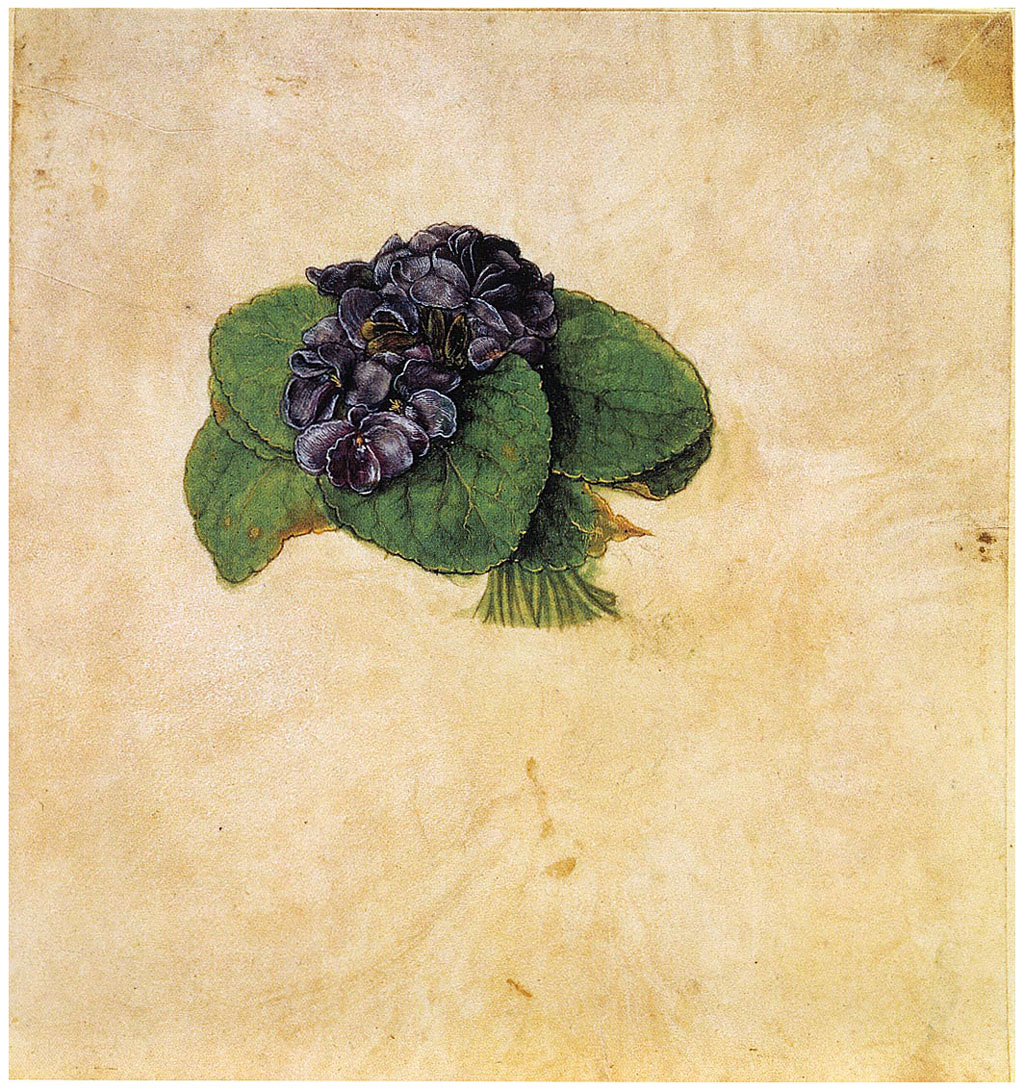
“Violet Bouquet” (1505)
“Violet Bouquet” (1505), a watercolor by the famous German artist Albrecht Durer, is one of several detailed studies he made of things he found interesting in nature. The heart-shaped and veined leaves encircle a small bouquet of the five-petaled purple flower. As a result of the small size of the flower, artists have chosen to paint them in a cluster. Leonardo da Vinci, also known for his intense interest in the study nature, made drawings of violets and other flowers.

Manuscript page (c.1585)
Violets were often illustrated in early medieval Books of Hours, personal devotional guides commissioned by the wealthy. The books, often dedicated to the Virgin Mary, included flower illustrations, because many flowers were symbolic of Mary’s many virtues. Violets were symbols of Mary’s humility as a result of their small size and because they were purple, the color of royalty. St Bernard (1090-1153) wrote of Mary as “the violet of humility, the lily of chastity, the rose of charity, the Balm of Gilead, and the golden gillyflower of heaven.”
The painted manuscript page (c.1585) by Jacques Moyne de Morgues is part of Paintings of Flowers, Butterflies, and Insects. De Morgues (1533-1588) was a French artist who in later life moved to England and became a well-regarded botanical artist. The five violets are symbols of Mary and the number of wounds Christ received on the cross. The butterfly is a symbol of Christ’s resurrection.
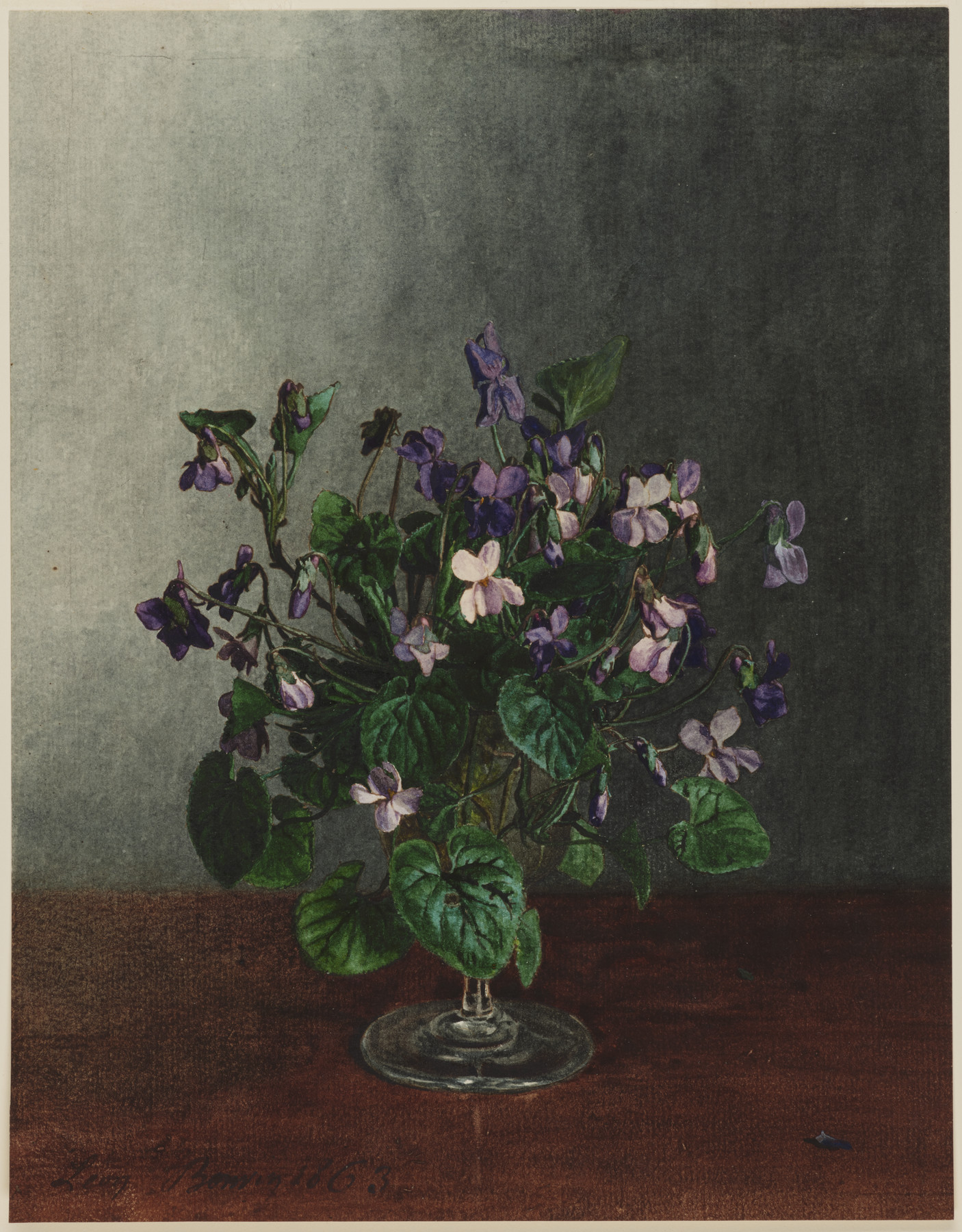
“Bouquet of Violets” (1863)
“Bouquet of Violets’’ (1863) (9.5’’x7.25’’) (watercolor) is by French painter Leon Bonvin (1834-1866). Bonvin was not well known during his short life, but he was appreciated by a prestigious, but small group of connoisseurs and collectors. A bouquet of white and purple violets is placed in a simple glass vase. The white violets, like most white flowers are symbols of innocence and purity. For Bonvin, a product of the Victorian era, the simplicity of the setting, the small size of the work, and the small bunch of violets, does much to show the humility but respect for the flower. The painting was commissioned by William T. Walters, the father of Henry Walters, founder of the Walters Art Museum in Baltimore. The works collected by William Walters were placed in deluxe leather-bound albums. He purchased Bonvin’s paintings between 1862 and1891. The Bonvin collection includes 56 watercolors and one oil painting, the largest collection of Bonvin’s work known today.
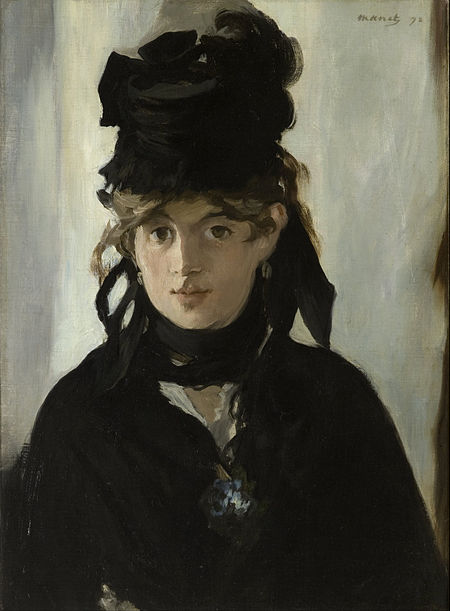
“Black Hat with Bouquet of Violets” (1872)
“Black Hat with Bouquet of Violets” (1872) is a portrait of Berthe Morisot, painted by Manet. In Victorian France and England, violets were one of the favorite flowers to paint in portraits of young women. Berthe Morisot and her sister were Manet’s students, and he featured her in several of his paintings. The bouquet of violets is pinned to her jacket, and its simplicity adds a touch of innocence and modesty. Morisot became an important Impressionist artist. As painted by Manet, Morisot is no “shrinking violet.” She confidently confronts the viewer head on. Portraits by other well-known French artists such as Chasseriau and Tissot, and the American Lily Cabot Perry, include violets as the only accessory.
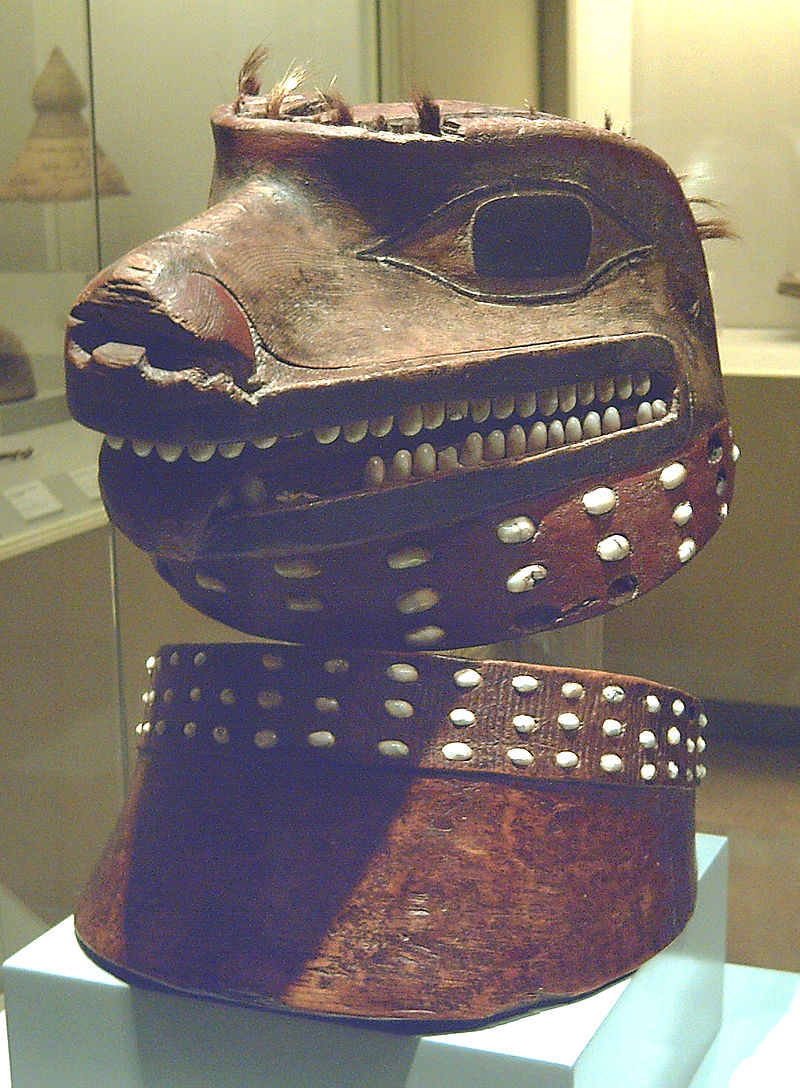
“Tlingit Wolf Helmet and Collar” (18th Century)
For those born between February 19 and March 20, the Native American totem animal is the wolf. Throughout history, the wolf has been recognized as a symbol of both good and evil. Native American tribes associate the wolf with loyalty to family, courage, strength, and success, especially as a hunter. The wolf is regarded with respect and reverence, and songs, stories, and dances include wolf medicine. Wolves also are thought to have supernatural powers.
“Tlingit Wolf Helmet and Collar” (18th Century) (wood, seashells, and mane) was worn when hunting wolves. The fierceness of the image was a tribute to the courage, power, and cunning of the wolf during the hunt. The Tlingit set traps and pitfalls to capture the wolves. After the hunt, they prayed over the dead bodies to ask the wolf spirit to forgive them. Praying to the spirit of the animal to be hunted to give itself to the hunter, or praying after the hunt, was a Native American tradition.
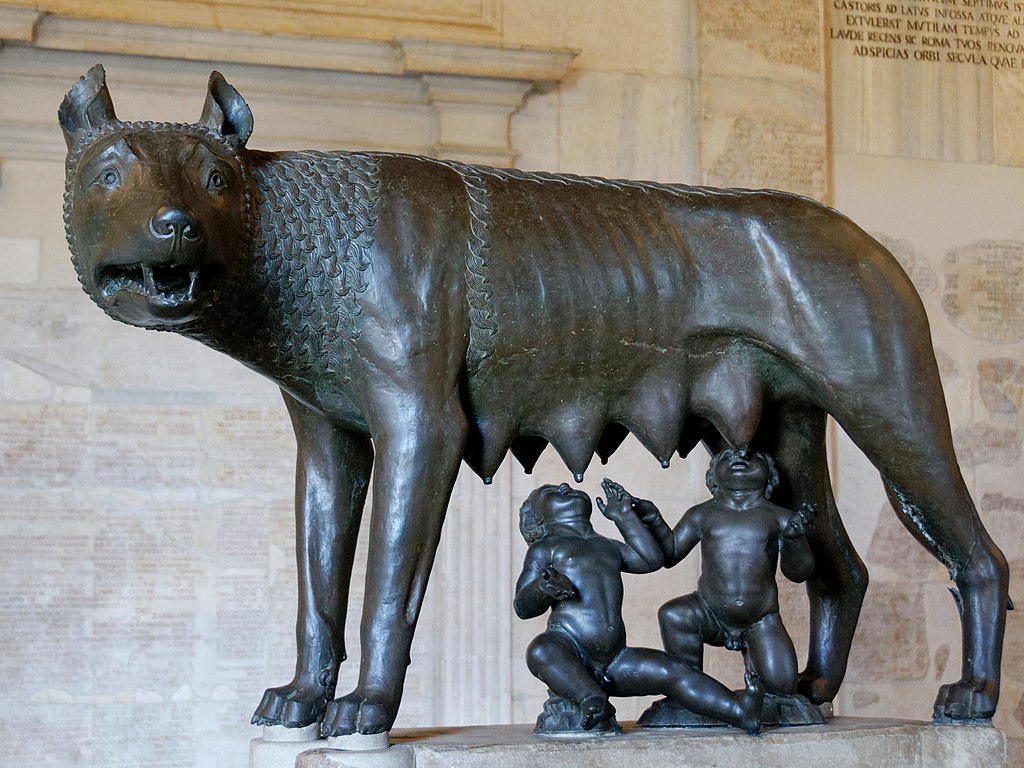
“She Wolf” (5th Century Etruscan)
The story of the founding of Rome begins with the two brothers Romulus and Remus (753 BCE), sons of Mars, the god of war and Rhea Silvia, a vestal virgin. Ordered to be killed by the reigning king, the twins were put in a basket and set adrift on the Tiber River. Tiberinus, god of the Tiber, rescued them, and a she-wolf suckled them. Later, they were raised by a shepherd and his wife. “She Wolf” (5th Century Etruscan) (30” x 45”) (bronze) (Capitoline Museum, Rome) celebrates this story and the wolf who saved Romulus and Remus. The city of Rome was built where they were found. The image of the watchful wolf is a larger-than-life 5th Century Etruscan work. The statue became the iconic symbol of Rome and was placed in a prominent location, duplicated on coins, and continues today to represent Rome. Romulus and Remus were added by the Italian Renaissance artist Pollaiuolo in the 15th Century.
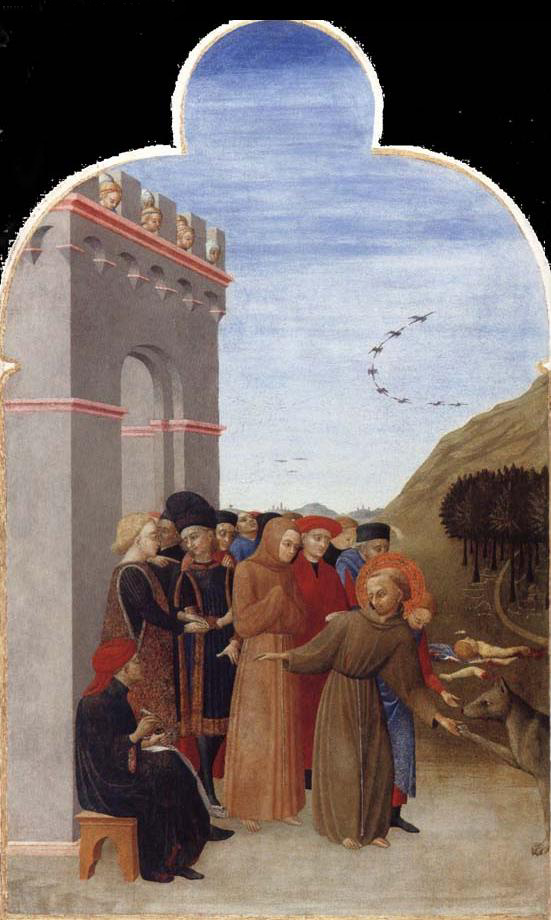
“St Francis and the Wolf of Gubbio” (1437-1444)
With the development of animal husbandry and the raising of flocks, wolf hunts became a necessity. Because wolfs travel in packs, they presented a greater danger to animals. The Roman poet Virgil (70-19 BCE) wrote in the Georgics that a wolf’s howl caused terror and that the frightened bleating of lambs would only encourage wolves. Wolves were cast as evil, cunning, and lacking any moral restraint in the New Testament. The Book of Matthew 7:15 warns, “Beware of false prophets, which come to you in sheep’s clothing, but inwardly they are ravening wolves.” “St Francis and the Wolf of Gubbio” (1437-1444) (fresco) refers to an interesting tale. The Italian city of Gubbio was under siege from a savage wolf who had turned from killing sheep to killing humans. No weapon could kill it. Francis made the sign of the cross and commanded the wolf to stop its attacks. The wolf came up to Francis, lay at his feet, and put its head in his hand. Francis made a pact with the wolf to end the battle with the town, and the wolf agreed. To the people of the town with the tame wolf, Francis said, “How much we ought to dread the jaws of hell, if the jaws of so small an animal as a wolf can make a whole city tremble through fear?” The “miracle” held, and the wolf and the people lived peacefully together.
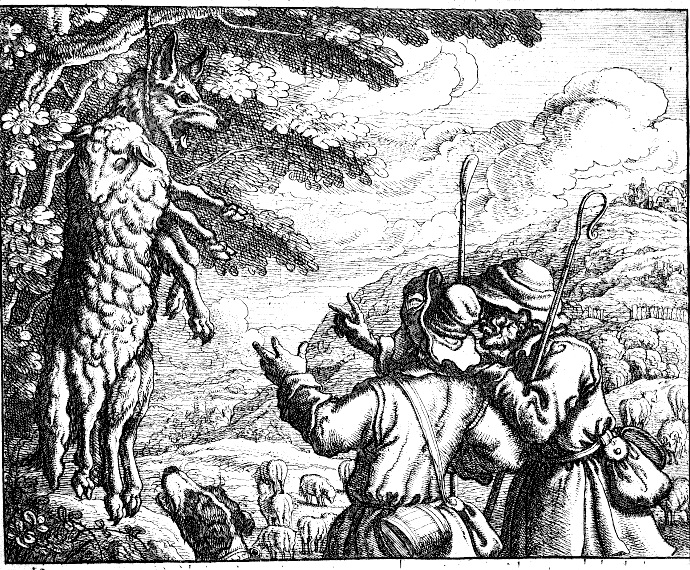
“Wolf in Sheep’s Clothing” (1687)
In every country where there were wolves, there also were legends of the wolf’s courage, strength, and loyalty to the wolf pack or family. Fairly or unfairly, the reputation of the wolf as vicious predator has endured throughout the centuries. Ovid’s Metamorphoses (8 CE) tells of the King of Lycaon, a cruel and blood thirsty ruler who challenged Zeus and was turned into a wolf, thus the first werewolf.
“A Wolf in Sheep’s Clothing” is a woodcut by Francis Barlow, published in Aesop’s Fables (1687). A wolf found a sheep skin and dressed in it to better kill the sheep. When it was captured, it was hung on a tree for all to see and celebrate.
In 1973, Congress placed the gray wolf on the endangered species list. As of February 10, 2022, gray wolves in 48 states and Mexico are protected under the Endangered Species Act. The International Wolf Center tracks wolf attacks on humans world-wide. The likelihood of a wolf attacking a human is not zero, but too small to calculate. Wolves in some areas of Europe have been extinct for over a century. The World Wildlife Federation and other organizations have been working to bring wolves back from extinction because they are a necessary part of the biosphere.
Beverly Hall Smith was a professor of art history for 40 years. Since retiring with her husband Kurt to Chestertown in 2014, she has taught art history classes at WC-ALL. She is also an artist whose work is sometimes in exhibitions at Chestertown RiverArts and she paints sets for the Garfield Center for the Arts.



Write a Letter to the Editor on this Article
We encourage readers to offer their point of view on this article by submitting the following form. Editing is sometimes necessary and is done at the discretion of the editorial staff.